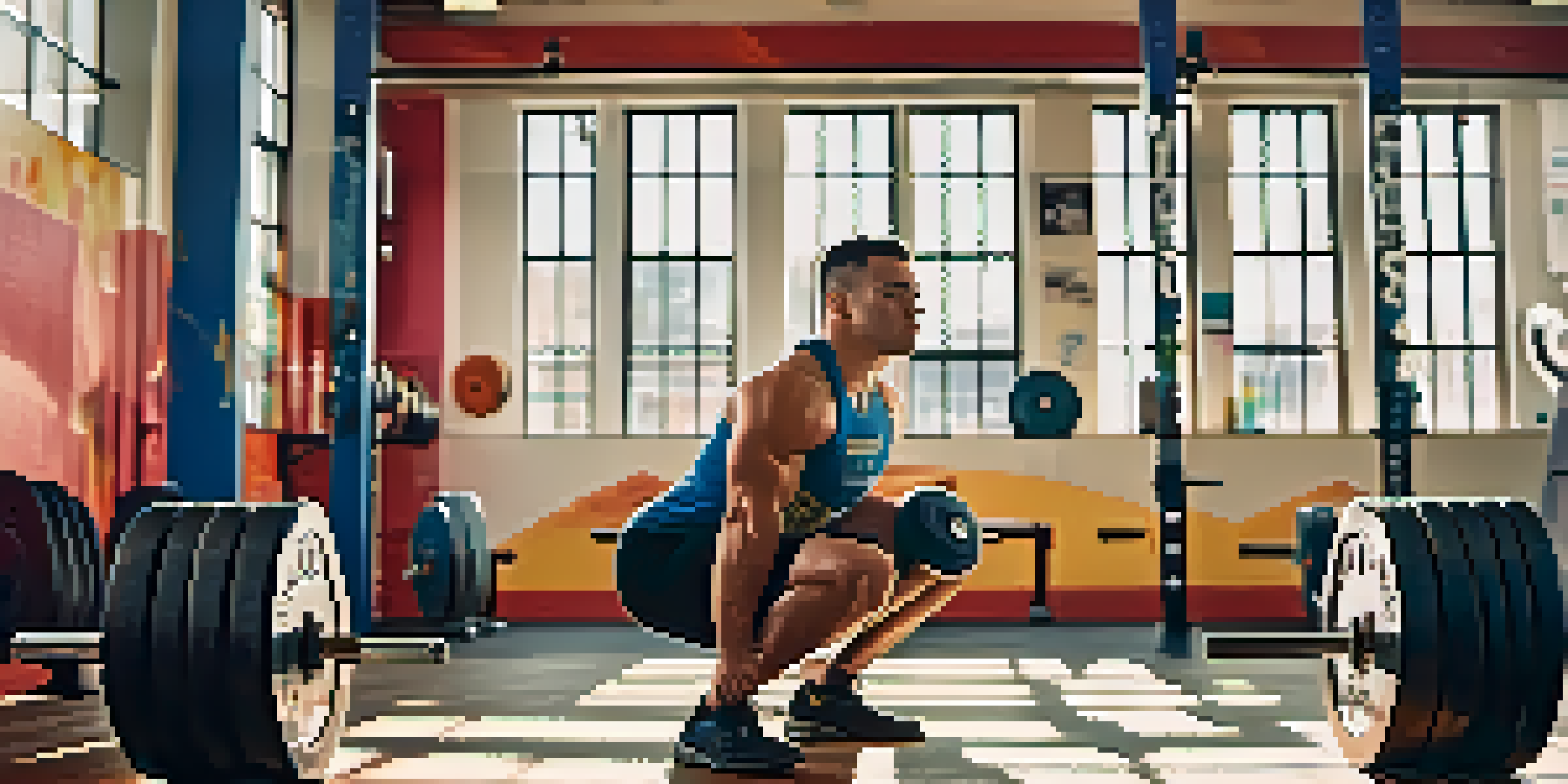Powerlifting Basics: A Guide to Weight Loss for Beginners

Understanding Powerlifting: The Foundation for Weight Loss
Powerlifting is a strength sport centered around three main lifts: the squat, bench press, and deadlift. These exercises not only build muscle but also boost your metabolism, making them effective for weight loss. By focusing on these compound movements, you'll engage multiple muscle groups, increasing calorie burn during and after your workout.
Strength does not come from physical capacity. It comes from an indomitable will.
When you lift heavier weights, your body requires more energy to recover, which can lead to increased fat loss over time. Think of it like revving up a car engine – the more you push it, the more fuel it consumes. This principle is what makes powerlifting a fantastic option for those looking to shed pounds while also gaining strength.
As a beginner, it's essential to learn proper form before diving into heavy lifting. Consider starting with lighter weights or even bodyweight exercises to build a solid foundation. This approach will help prevent injuries and ensure that you’re getting the most out of each lift.
Setting Realistic Goals for Your Powerlifting Journey
One of the keys to success in powerlifting, especially for weight loss, is setting achievable goals. Instead of aiming for drastic weight loss in a short amount of time, focus on small, incremental changes. This could mean aiming to lose one to two pounds a week or improving your lifting technique each month.

Having clear, realistic goals not only keeps you motivated but also allows you to track your progress effectively. For example, if your goal is to squat your body weight within six months, you can break this down into smaller milestones to celebrate along the way. Every small victory adds up and makes the journey more enjoyable.
Powerlifting Boosts Weight Loss
Powerlifting's focus on compound movements like squats, bench presses, and deadlifts not only builds muscle but also enhances metabolism, making it effective for weight loss.
Additionally, don’t forget to celebrate non-scale victories, such as increased strength or improved endurance. These achievements are just as important as the number on the scale and can help keep your spirits high as you work towards your weight loss goals.
Nutrition Essentials: Fueling Your Powerlifting Workouts
Nutrition plays a critical role in both powerlifting and weight loss. To fuel your workouts, focus on a balanced diet rich in protein, healthy fats, and complex carbohydrates. Protein is particularly important for muscle repair and growth, so consider incorporating sources like chicken, fish, legumes, and dairy into your meals.
The only bad workout is the one that didn’t happen.
It's also vital to pay attention to portion sizes and overall caloric intake. Tracking your meals can be an eye-opener, helping you understand what you’re consuming and how it affects your weight loss journey. Apps like MyFitnessPal can assist you in keeping tabs on your nutrition without the guesswork.
Finally, stay hydrated! Water is essential for optimal performance and recovery. A well-hydrated body can recover faster after intense lifting sessions, allowing you to push harder during your next workout.
Creating a Powerlifting Routine for Beginners
A well-structured powerlifting routine is crucial for beginners. Start with a three to four-day workout schedule focusing on the three primary lifts, allowing for adequate recovery time in between sessions. For instance, you might squat on Mondays, bench press on Wednesdays, and deadlift on Fridays.
Incorporating accessory exercises is also beneficial. These are movements that support your main lifts and help build overall strength, such as lunges, rows, and overhead presses. Think of them as the side dishes to your main course; they enhance your meal and contribute to your overall goals.
Set Achievable Goals
Establishing realistic, incremental goals keeps motivation high and allows you to track progress effectively on your powerlifting journey.
As you progress, don’t hesitate to adjust your routine. Listen to your body and modify your plan based on how you feel. If you’re fatigued or not seeing results, it may be time to reassess your workout intensity or frequency.
The Importance of Rest and Recovery in Powerlifting
Rest and recovery are often overlooked but are just as important as the workouts themselves. Your muscles need time to repair and grow stronger after lifting heavy weights. Neglecting rest can lead to burnout and injuries, ultimately hindering your weight loss efforts.
Aim for at least one to two rest days each week to allow your body to recuperate. This doesn’t mean you have to be inactive; consider incorporating light activities like walking or yoga on these days to keep your body moving without overexerting yourself.
Sleep is another crucial component of recovery. Aim for 7-9 hours of quality sleep each night, as this is when your body does much of its repair work. A well-rested body is not only more effective in the gym but also better equipped to tackle weight loss challenges.
Staying Motivated: Overcoming Challenges in Your Journey
Every fitness journey comes with its ups and downs. It's normal to face challenges, whether it’s a plateau in weight loss or difficulty in lifting heavier weights. The key is to stay motivated and remind yourself why you started in the first place.
Consider finding a workout buddy or joining a powerlifting community. Surrounding yourself with like-minded individuals can provide support, encouragement, and accountability. Plus, having someone to share your journey with makes it more enjoyable.
Powerlifting Boosts Weight Loss
Engaging in powerlifting's compound lifts increases calorie burn and boosts metabolism, aiding in weight loss.
Lastly, focus on the process rather than just the end goal. Celebrate your efforts and improvements along the way, no matter how small they may seem. Keeping a positive mindset can make a significant difference in how you approach your training and weight loss journey.
Listening to Your Body: Knowing When to Seek Help
As you embark on your powerlifting journey, it’s vital to listen to your body. If you experience persistent pain or discomfort, it may be a sign to reassess your form or take a break. Ignoring these signals can lead to injuries that could derail your progress.
Don’t hesitate to seek help from a coach or trainer, especially if you’re unsure about your lifting technique. They can provide valuable insights and adjustments to help you lift safely and effectively. An expert can also tailor a program to your specific needs, enhancing your results.

Remember, it’s okay to ask for support when you need it. Whether it’s through professional guidance or leaning on friends and family, having a support system can make all the difference in your weight loss and powerlifting journey.